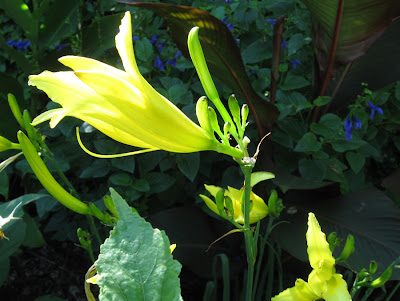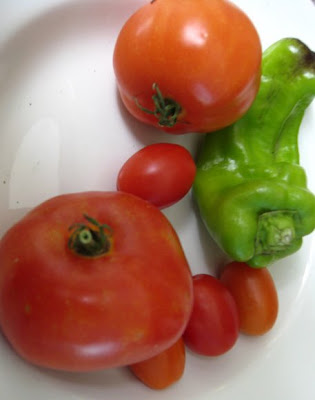 This morning I was later than usual in leaving the campground. It had rained all night. I think there is something about a rainy morning that just makes you want to sleep in. It was 10 o'clock when I left Tok and it was drizzling. I felt sorry for these motorcycle riders who passed me. It can't be much fun riding in the rain.
This morning I was later than usual in leaving the campground. It had rained all night. I think there is something about a rainy morning that just makes you want to sleep in. It was 10 o'clock when I left Tok and it was drizzling. I felt sorry for these motorcycle riders who passed me. It can't be much fun riding in the rain.To the west, the direction I was headed, the skies appeared to be clearing up a bit. To the east, gray, heavy clouds filled the sky. I hoped that Sue and Fred, who were a little more than a day behind, weren't getting a lot of rain.
 About ten miles west of Tok I glimpsed this pond out the side window. It took my breath away! I had to turn around and go back. It was just a few feet off the highway. There was no other traffic at the time and I felt as though I was alone with the universe. It was so incredibly beautiful.
About ten miles west of Tok I glimpsed this pond out the side window. It took my breath away! I had to turn around and go back. It was just a few feet off the highway. There was no other traffic at the time and I felt as though I was alone with the universe. It was so incredibly beautiful.The blue skies lasted another twenty minutes down the highway, then the gray stuff made it's way back. A little rain now and then too.
 And then, a little over two and a half hours after leaving Tok, there it was. On a curve going into Delta Junction - the “official” end of the Alaska Highway. 1422 miles (nearly 2500 miles since leaving Roosville, Montana). At times it seemed like an endless highway; going up, down, curving around, seldom straight, but tree-lined with glimpses of far off vistas.
And then, a little over two and a half hours after leaving Tok, there it was. On a curve going into Delta Junction - the “official” end of the Alaska Highway. 1422 miles (nearly 2500 miles since leaving Roosville, Montana). At times it seemed like an endless highway; going up, down, curving around, seldom straight, but tree-lined with glimpses of far off vistas. I made it! And in a few weeks, I'll have to do it again (at least part of it).
I made it! And in a few weeks, I'll have to do it again (at least part of it).I've been in touch with Sue and Fred along the way. They are a little over a day behind me but we'll meet up on Sunday at Denali National Park. It has been rather comforting, in an odd sort of way I suppose, to know that they were following me. Knowing that they would be along if something happened along the way.
Just before they left Louisiana, Sue started a blog - Notes from the Cabin....and beyond in which she has been chronicling their fall trip. Sue and Fred are what you might call “planners” which is a somewhat different approach to my method of travel. They have had better internet access than I have and Sue has written much more than I have too – and written quite well, I might add. You might enjoy reading what she has to say about their journey...
I'm currently at the very pleasant public library in Delta Junction, immensely enjoying their fast wifi. Shortly, I will be heading north towards Fairbanks. The Tanana Valley State Fair starts today in Fairbanks so I'm a little concerned with finding a place to stay and may stop just before getting to Fairbanks, making it one of the shorter drive-days. I considered taking the Denali Highway over to Denali but it is a gravel road and it has been raining so it can be a bit slippery. Besides I need to refill my cooler and cupboards as I've eaten nearly everything I brought! So toward Fairbanks I'll be heading.
Photographs taken August 6, ...














 Sunny is our oldest horse. We think he is around 25 years. He would eat us out of house and home if we would let him. He thinks we should feed him 24 hours a day. And grumbles when we don't and when we do. We feed him what the vet says to feed him. He has a big belly but his backbone shows. Vet says we need to re-arrange his body. Says he needs more excersise to do that. But I find it hard to excersise me or the horses when it is as hot as it has been this summer. But we are going to start trying to do more. In the mean time Sunny thinks his retirement is going great. he is a sweet old horse, who loves to be petted, groomed and bathed. I bet he was one heck of a horse when he was young. I don't know anything about who had him or what his life was like then. He and my QH mare, Nita, are best friends.
Sunny is our oldest horse. We think he is around 25 years. He would eat us out of house and home if we would let him. He thinks we should feed him 24 hours a day. And grumbles when we don't and when we do. We feed him what the vet says to feed him. He has a big belly but his backbone shows. Vet says we need to re-arrange his body. Says he needs more excersise to do that. But I find it hard to excersise me or the horses when it is as hot as it has been this summer. But we are going to start trying to do more. In the mean time Sunny thinks his retirement is going great. he is a sweet old horse, who loves to be petted, groomed and bathed. I bet he was one heck of a horse when he was young. I don't know anything about who had him or what his life was like then. He and my QH mare, Nita, are best friends.



 As I left Indiana on Sunday morning, I wasn't too concerned with what the weather was doing in Kentucky and Tennessee. According to reports, the ice and snow would have finished falling before I got there. And the reports were right, but it sure did leave a "mess" all along the I-40 corridor from Oklahoma to the Carolinas and Virginia. Interstate 65 was clear all the way but through Nashville the exit and entrance ramps were in horrible shape and from what I saw on the news many of the secondary roads were still snow covered and icy this morning.
As I left Indiana on Sunday morning, I wasn't too concerned with what the weather was doing in Kentucky and Tennessee. According to reports, the ice and snow would have finished falling before I got there. And the reports were right, but it sure did leave a "mess" all along the I-40 corridor from Oklahoma to the Carolinas and Virginia. Interstate 65 was clear all the way but through Nashville the exit and entrance ramps were in horrible shape and from what I saw on the news many of the secondary roads were still snow covered and icy this morning.





 A portion of the Cliff Palace seen from the top of the trail. A large part of the dwelling is off to the left and much of it is barely visible in the shadows.
A portion of the Cliff Palace seen from the top of the trail. A large part of the dwelling is off to the left and much of it is barely visible in the shadows.



 The park Ranger preparing to climb the last of the ladders back to the top.
The park Ranger preparing to climb the last of the ladders back to the top. At first glimpse, and from a distance, the final ladder climb looks scary. This was taken from the trail waiting area before going on the tour. But, as you can see from the previous photo, the ladder hugs the wall and it was a relatively easy climb.
At first glimpse, and from a distance, the final ladder climb looks scary. This was taken from the trail waiting area before going on the tour. But, as you can see from the previous photo, the ladder hugs the wall and it was a relatively easy climb.













